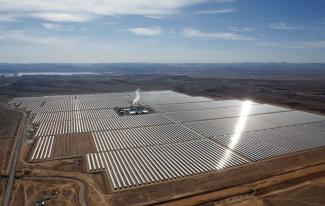Renewable energy
Emerging markets overtake industrialised states

Global investments in renewable energy are at an all-time high. According to the report “Global trends in renewable energy investment”, $ 286 billion were invested in solar, wind and other renewables in 2015, up 5 % from 2014. For the first time last year, renewables accounted for over half – 53 % – of the increase in power generation capacity.
With $ 107 billion and $ 80.9 billion in investments respectively, wind and solar power took in the most money by far. They also achieved the highest levels of growth: investments in solar power rose 12 % compared to the previous year and investments in wind grew by 9 %. Investments in all other renewable energy sources were down compared to 2014.
“Much of the action is taking place in developing countries and emerging markets,” emphasised Martin Cremer, co-editor of the joint report by the Frankfurt School-UNEP Collaborating Centre and Bloomberg New Energy Finance at the launch in Frankfurt at the end of March. The report shows that investments from non-OECD countries as well as Chile, Turkey and Mexico exceeded investments from industrialised countries for the first time. With $ 103 billion in investments, China is the clear frontrunner: it is now responsible for over a third of all investments in renewable energy worldwide.
According to Cremer, developing countries have also realised that renewable energy is indispensable. Investments in those countries are reportedly up 30 % from the previous year, though they remain low. “The business climate is the decisive factor in developing countries”, Cremer explains. “Is there security for investors? Is there a regulatory agency?”
Ulf Moslener, another co-editor of the report, points out that despite record investments, renewable energy still accounts for only 16.2 % of power generation capacity worldwide. “It's even more sobering to consider that renewables actually only make up 10.3 % of the electricity mix.” This discrepancy is due to the fact that wind and solar power are not always available and plants often cannot make full use of their capacities.
Moslener also calls attention to the circumstance that especially in developing and newly industrialising countries, power plant complexes are relatively new. “At least half of the world's coal-burning power plants are under 23 years old. If we assume a service life of 40 years, they will be operational for another 17 years or more.” However, the goals agreed at the United Nations Climate Change Conference in Paris presume that fossil fuels will be phased out in the second half of this century. “We must do more than develop renewables in order for that to happen”, Moslener cautions.
Electricity storage is a particularly important consideration. Storing energy offers a way to react to variable power generation from wind and solar and to deal with spikes in consumer demand. According to the report, 250 megawatts of energy storage capacity were added worldwide in 2015, excluding pumped hydro and lead-acid batteries, compared to an increase of only 160 megawatts in 2014. Silvia Kreibiehl, Head of the Frankfurt School-UNEP Collaborating Centre for Climate & Sustainable Energy Finance, thinks it is essential that energy markets be restructured in order to accommodate even greater shares of renewable energy. To that end, “investments in storage media and the expansion of the grid must play a larger role in the future”.
The authors expect that the trend will continue and that both investments in renewable energy as well as renewables’ share in the energy mix will continue to rise. They predict that if the cost of technology continues to fall, the policy environment will become less and less important. “The available resources will become the main drivers,” Moslener believes. According to that theory, countries with the highest feed-in tariffs would no longer be at the forefront. Instead, they would be replaced by countries with the most sunlight and the best wind conditions – a trend that is already playing out.
Katja Dombrowski
Link
Global trends in renewable energy investment 2016 report:
http://fs-unep-centre.org/publications/global-trends-renewable-energy-investment-2016










